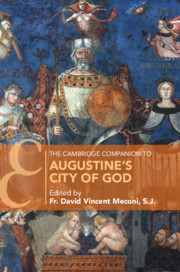76 results
Abbreviations: Works by Augustine
-
- Book:
- The Cambridge Companion to Augustine's City of God
- Published online:
- 21 August 2021
- Print publication:
- 26 August 2021, pp xvii-xx
-
- Chapter
- Export citation
Contents
-
- Book:
- The Cambridge Companion to Augustine's City of God
- Published online:
- 21 August 2021
- Print publication:
- 26 August 2021, pp ix-x
-
- Chapter
- Export citation
Dedication
-
- Book:
- The Cambridge Companion to Augustine's City of God
- Published online:
- 21 August 2021
- Print publication:
- 26 August 2021, pp vii-viii
-
- Chapter
- Export citation
References
-
- Book:
- The Cambridge Companion to Augustine's City of God
- Published online:
- 21 August 2021
- Print publication:
- 26 August 2021, pp 321-338
-
- Chapter
- Export citation
Preface
-
- Book:
- The Cambridge Companion to Augustine's City of God
- Published online:
- 21 August 2021
- Print publication:
- 26 August 2021, pp xv-xvi
-
- Chapter
- Export citation
Copyright page
-
- Book:
- The Cambridge Companion to Augustine's City of God
- Published online:
- 21 August 2021
- Print publication:
- 26 August 2021, pp vi-vi
-
- Chapter
- Export citation
Index
-
- Book:
- The Cambridge Companion to Augustine's City of God
- Published online:
- 21 August 2021
- Print publication:
- 26 August 2021, pp 339-348
-
- Chapter
- Export citation
Notes on Contributors
-
- Book:
- The Cambridge Companion to Augustine's City of God
- Published online:
- 21 August 2021
- Print publication:
- 26 August 2021, pp xi-xiv
-
- Chapter
- Export citation

The Cambridge Companion to Augustine's City of God
-
- Published online:
- 21 August 2021
- Print publication:
- 26 August 2021
Cannabis, mind, and mirth
-
- Journal:
- European Psychiatry / Volume 11 / Issue 7 / 1996
- Published online by Cambridge University Press:
- 16 April 2020, pp. 329-334
-
- Article
- Export citation
12 - Christological and Ecclesiological Narratives in Early Eighth-Century Greek Homilies on the Theotokos
- from Part III - Preaching her Story
-
-
- Book:
- The Reception of the Virgin in Byzantium
- Published online:
- 05 August 2019
- Print publication:
- 15 August 2019, pp 257-280
-
- Chapter
- Export citation
15 - The Story of an EditionAntoine Wenger and John Geometres’ Life of the Virgin Mary
- from Part IV - New Narratives in the Middle Byzantine Period
-
-
- Book:
- The Reception of the Virgin in Byzantium
- Published online:
- 05 August 2019
- Print publication:
- 15 August 2019, pp 324-340
-
- Chapter
- Export citation
9 - The Spiritual and Material Temple
- from Part II - Song and Celebration
-
-
- Book:
- The Reception of the Virgin in Byzantium
- Published online:
- 05 August 2019
- Print publication:
- 15 August 2019, pp 192-214
-
- Chapter
- Export citation
Chapter Eleven - St. Thomas Aquinas (1225–74 CE ) at Santa Sabina, the Angelicum, and the Basilica di Santa Maria Sopra Minerva
-
-
- Book:
- People and Places of the Roman Past
- Published by:
- Amsterdam University Press
- Published online:
- 20 November 2020
- Print publication:
- 30 April 2019, pp 123-134
-
- Chapter
- Export citation
Chapter Seventeen - St. Peter (ca. 10–64 CE ) and St. Paul (5–67 CE ) at the Basilica di San Pietro, the Basilica di San Paolo Fuori le Mura, and the Abbazia delle Tre Fontane
-
-
- Book:
- People and Places of the Roman Past
- Published by:
- Amsterdam University Press
- Published online:
- 20 November 2020
- Print publication:
- 30 April 2019, pp 199-210
-
- Chapter
- Export citation
08 Inhibition of autophagy by mevalonate pathway inhibitors, a new therapeutic approach to sensitize glioblastoma cells to temozolomide induced apoptosis
-
- Journal:
- Canadian Journal of Neurological Sciences / Volume 45 / Issue S3 / June 2018
- Published online by Cambridge University Press:
- 27 July 2018, pp. S1-S2
-
- Article
-
- You have access
- Export citation
The impact of African aridity on the isotopic signature of Atlantic deep waters across the Middle Pleistocene Transition
-
- Journal:
- Quaternary Research / Volume 77 / Issue 1 / January 2012
- Published online by Cambridge University Press:
- 20 January 2017, pp. 182-191
-
- Article
- Export citation
Thoughts on the Initial Adaptation of Hominids to European Glacial Climates
-
- Journal:
- Quaternary Research / Volume 8 / Issue 1 / July 1977
- Published online by Cambridge University Press:
- 20 January 2017, pp. 115-127
-
- Article
- Export citation
Foreword
-
-
- Book:
- Introduction to the Senses
- Published online:
- 05 July 2012
- Print publication:
- 01 June 2012, pp ix-x
-
- Chapter
- Export citation
Gold Labeling of Protein Fusion Tags for EM
-
- Journal:
- Microscopy and Microanalysis / Volume 16 / Issue S2 / July 2010
- Published online by Cambridge University Press:
- 01 August 2010, pp. 866-867
- Print publication:
- July 2010
-
- Article
-
- You have access
- Export citation



